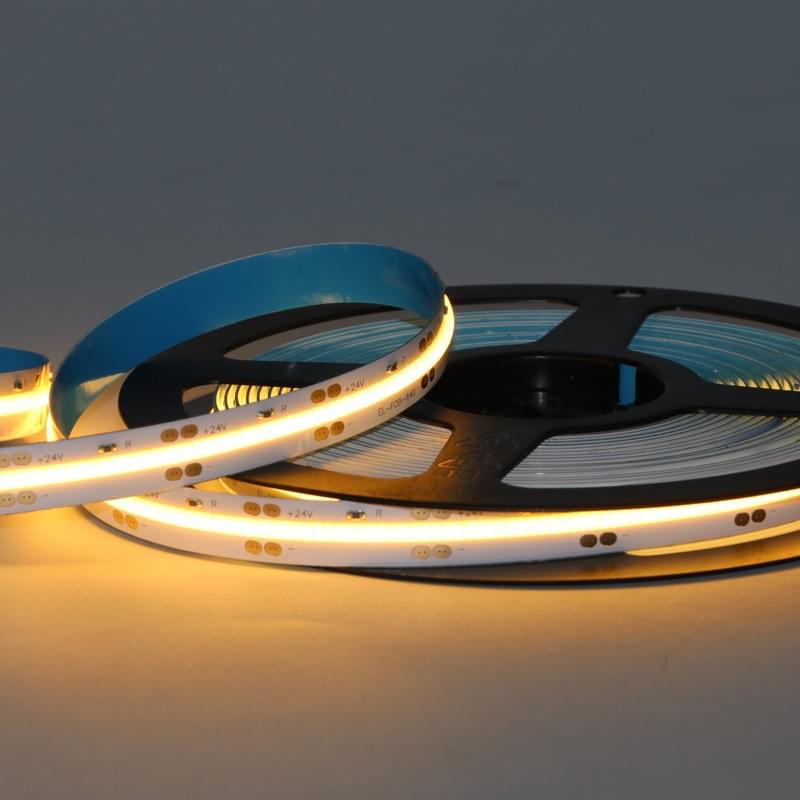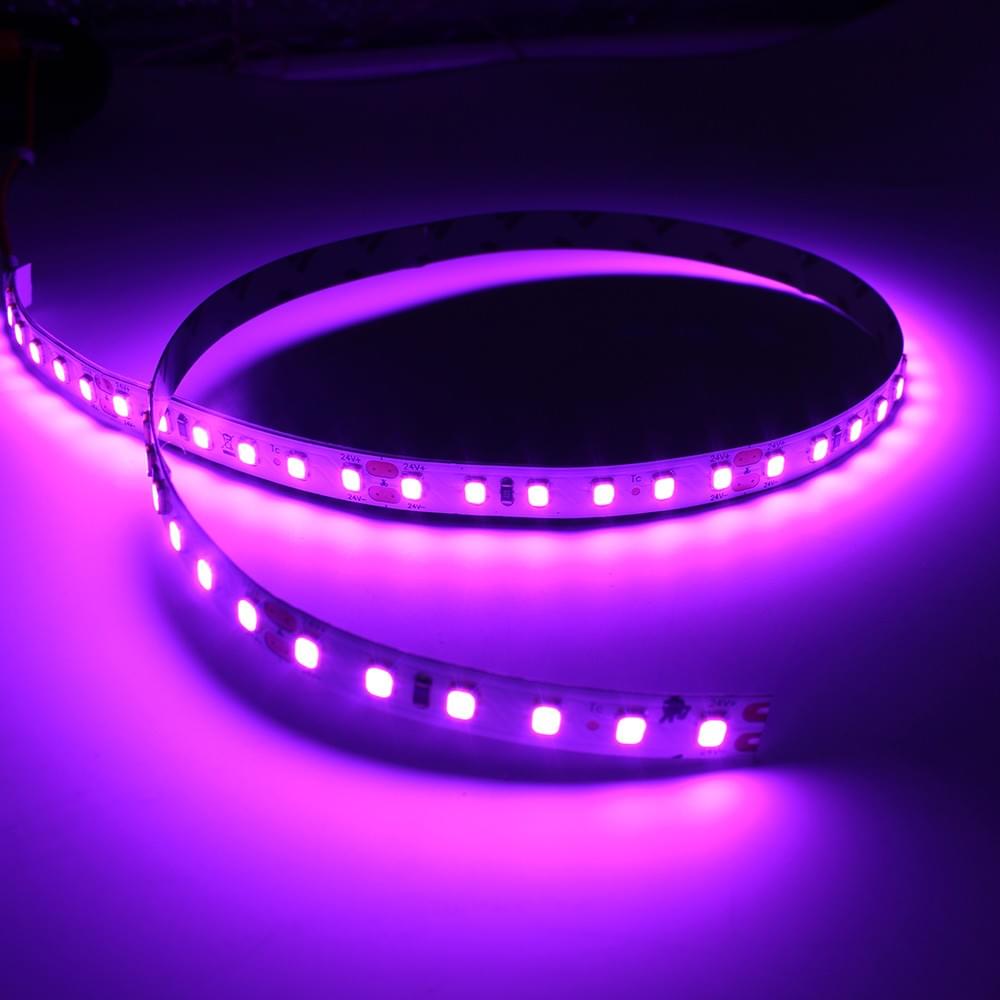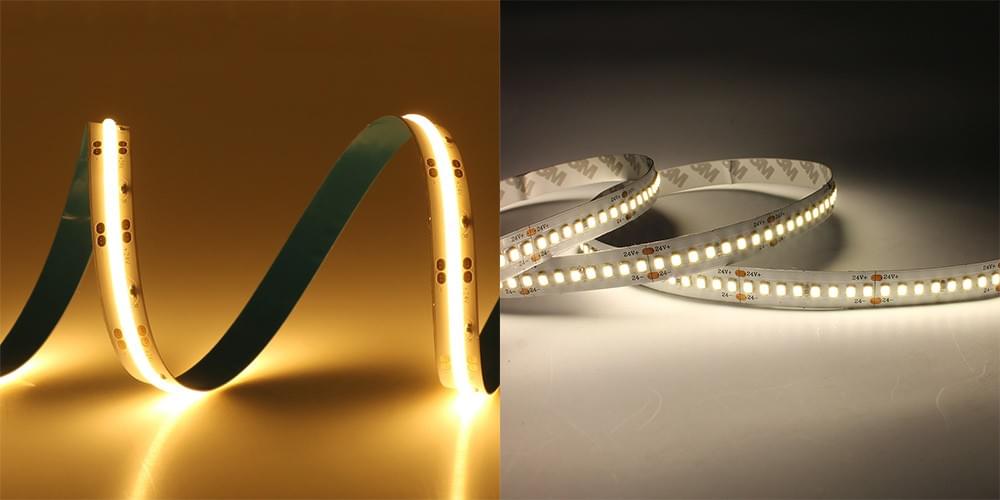COB LED Strip vs. SMD LED Strip: Dot Free LED Tape Lighting Guide
COB LED Strip vs. SMD LED Strip: Dot Free LED Tape Lighting Guide
If you’re researching “cob led strip” and trying to decide whether it’s better than a traditional SMD LED strip, you’re in the right place. This in-depth guide explains how COB and SMD technologies work, where each one shines, and exactly how to choose, install, and maintain the best LED strip lights for your project. You’ll learn about brightness, color quality, dot-free diffusion, efficiency, heat, dimming, cutting, smart control, and safety certifications—plus get practical checklists and FAQs to help you buy with confidence.
Use this guide whether you’re outfitting a retail display, upgrading under-cabinet lighting, building custom signage, or planning an architectural cove. By the end, you’ll know precisely when a COB LED strip is the smarter choice and when an SMD LED strip still makes sense.

What Is a COB LED Strip?
A COB LED strip uses Chip-On-Board technology: hundreds or even thousands of tiny LED dies are mounted directly onto the flexible PCB and then covered with a continuous phosphor layer. Instead of seeing individual LED “dots,” a COB strip appears as a smooth, uniform line of light—even at very short viewing distances or in shallow profiles. Because the phosphor blends the point sources into a single luminous surface, COB strips excel in dot-free applications like task lighting, accent lines, and visible architectural details.
Key traits of a COB LED strip:
· Extremely high LED density (often 320–840+ LEDs per meter, sometimes effectively “continuous”).
· Seamless, dot-free illumination without a diffuser—or with a very low-profile lens.
· Excellent color mixing and uniformity due to the phosphor layer.
· Flexible and cuttable, with 24 V or 12 V versions common, and growing 48 V options for long runs.

What Is an SMD LED Strip?
An SMD LED strip uses discrete surface-mount LED packages (e.g., 2835, 3528, 5050, 2216) soldered along a flexible PCB at regular intervals (e.g., 60, 120, or 180 LEDs per meter). SMD strips are the classic tape-light style: easy to source, broad range of colors and brightness levels, and compatible with a huge ecosystem of controllers and profiles.
Key traits of an SMD LED strip:
· Visible LED points unless installed with sufficient diffusion distance.
· Wide range of package sizes to balance brightness, efficiency, and cost.
· Mature, commoditized product category with many options and price tiers.
· Often slightly easier to rework at component level (replaceable packages) for advanced users.
COB LED Strip vs. SMD LED Strip: The Short Answer

· Choose a cob led strip when you need dot-free, continuous lines of light, excellent uniformity at close range, and premium aesthetics with minimal diffusion hardware.
· Choose an SMD LED strip when you prioritize budget, need specialized colors (like addressable RGB/RGBW with integrated ICs), or you can tuck the strip behind a deep diffuser where dots won’t be visible.
Deep Dive: 12 Factors That Actually Matter
1) Visual Unifor
mity and the “Dot-Free” Look
· COB: Appears as a continuous luminous line. Ideal for under-cabinet edges, toe-kicks, backlit reveals, and any surface where the light source may be directly visible. In most cases, you can skip a deep diffuser and still avoid hotspots.
· SMD: Shows dots unless you increase the diffuser depth, use high-density variants, or position the strip far enough from the illuminated surface. In shallow channels, dots are usually noticeable.
Bottom line: For seamless aesthetics and ultra-short viewing distances, COB wins.
2) Brightness and Luminous Efficacy
· COB: Modern cob led strip designs can be very bright with impressive lumens per watt, especially in 24 V and 48 V configurations that reduce current per segment and improve efficiency. The phosphor layer introduces small losses, but the uniform mixing can boost perceived brightness.
· SMD: Wide spectrum of brightness levels, from low-power ambient options to very high-output commercial strips. With efficient 2835/2216 packages, SMD strips can match or exceed COB efficacy in some models. Because there’s no continuous phosphor coating, absolute efficacy can be slightly higher on certain SMD lines.
Bottom line: It’s a tie on paper; look at real-world lumen output per meter and watts per meter for the specific model you’re comparing.
3) Color Quality (CRI, R9, TLCI)
· COB: Many premium cob led strip products now offer 95+ CRI with strong R9 values for natural reds—great for residential kitchens, retail fashion, and hospitality.
· SMD: Likewise available in high CRI. Historically, high-CRI SMD options were more common; today, high-CRI COB is easy to find.
Bottom line: Both can deliver excellent color; verify CRI/R9/TM-30 specs in the datasheet.
4) Color Temperatures and Tunable White
· COB: Available from warm 2200 K up to 6500 K+, with growing CCT options in tunable white (CCT-adjustable) strips that place two COB lines side-by-side under a single phosphor strategy or alternate segments.
· SMD: Extremely broad selection, including single CCT, tunable white (CCT adjustable), and RGB/RGBW/RGBCCT.
Bottom line: For RGB/RGBW effects, SMD still has the edge. For clean white light across CCTs, COB is excellent.
5) Dot�Free Diffusion in Slim Profiles
· COB: Because the luminous surface is continuous, you can use thin aluminum channels and still get a smooth line. This reduces build height, weight, and cost of accessories.
· SMD: Requires more diffuser depth or a high-density strip to hide dots. Deep channels increase material cost and may limit design freedom.
Bottom line: If your profile depth is limited, COB simplifies the build.
6) Flexibility, Cutting, and Bending Radius
· COB: The absence of bulky LEDpackages can improve flexibility. Many COB strips have small cut intervals (e.g., 25–50 mm for 24 V), letting you dial in precise lengths. Minimum bend radius is similar to SMD, but avoid sharp folds at cut pads.
· SMD: Comparable flexibility overall. Cut increments vary by LED density and voltage (e.g., 25–100 mm).
Bottom line: Both are flexible. COB often gives finer cut resolution, which helps fit tight runs.
7) Voltage Options and Run Lengths
· 12 V: Shorter segments, easier small dimming zones, but higher voltage drop over long runs.
· 24 V: The sweet spot for most projects—good balance of segment length, consistent brightness, and driver availability.
· 48 V: Emerging in both COB and SMD for very long runs with reduced current and voltage drop, useful in commercial linear lighting.
Bottom line: For long continuous lines, consider 24 V or 48 V, regardless of COB or SMD.
8) Dimming and Control Compatibility
· COB: Works with PWM dimmers, 0–10 V drivers, TRIAC/ELV dimmable power supplies, and smart controllers. The continuous light surface often looks smoother at low dim levels.
· SMD: Equally compatible, with the additional advantage of many addressable options (e.g., WS2812B/LED ICs) for pixel effects in RGB strips.
Bottom line: For dynamic, addressable color effects, SMD dominates. For smooth white-light dimming, COB is excellent.
9) Thermal Performance and Lifespan
· COB: High LED density concentrates heat, so aluminum channels or proper heat-spreading surfaces are recommended for medium-to-high wattage. When adequately cooled and driven within spec, lifespan rivals SMD.
· SMD: Similar rules apply. Package-level thermal paths can be well-understood and predictable; many premium SMD strips run cool and last long with good heatsinking.
Bottom line: Thermal management matters for both. Mount on metal where possible and avoid overdriving.
10) Installation Speed and Aesthetics
· COB: Fewer accessories needed to hide dots means faster installs and cleaner lines. If you’re doing dozens of meters, this saves time.
· SMD: If you need deep channels and precise spacing to eliminate hotspots, installation can be slower. But for hidden coves, the difference is minor.
Bottom line: Visible runs favor COB for speed and finish quality.
11) Cost and Availability
· COB: Often slightly more expensive per meter than entry-level SMD, but you may save on diffusers and profiles. As adoption grows, prices are narrowing.
· SMD: Very broad price range. Budget SMD can be significantly cheaper, but quality varies widely—pay attention to binning, CRI, and copper weight of the PCB.
Bottom line: If budget is tight and the light is hidden, SMD may be more economical; for premium visible lines, COB’s value is compelling.
12) Reliability, Warranty, and Certifications
· COB: Look for UL/ETL (in North America), CE/UKCA, RoHS, and documentation on LM-80/LM-79 or TM-30 reports. Ensure consistent phosphor quality and proper encapsulation against moisture.
· SMD: Same advice. Because the category is mature, it’s easier to find long-standing models with proven track records.
Bottom line: Certifications, test data, and brand support matter more than the LED type.

Practical Use Cases: When Each Type Excels
Choose a cob led strip for:
· Under cabinet lighting where the strip is close to the countertop and you want a smooth, professional task light.
· Architectural accents along walls, ceiling reveals, and stair treads where viewers can see the light source directly.
· Retail shelves and display cases requiring premium presentation, high CRI, and dot-free edges.
· Signage outlines and backlighting behind thin materials where hotspotting would be obvious.
· Residential features like cove lights, toe-kicks, and mirror backlights without bulky diffusers.
Choose an SMD LED strip for:
· Hidden coves and indirect lighting where dots won’t be visible.
· RGB/RGBW effects, pixel mapping, and addressable installations for entertainment, gaming rooms, or stage design.
· Cost-sensitive projects that still demand reliable, efficient white light in deep profiles.
· Specialty colors or very high output models available only in specific SMD packages.
How to Choose the Right COB LED Strip (or SMD) for Your Project
Follow this checklist to avoid common pitfalls:
Define your li
ghting goal:
· Task, accent, or ambient? For task lighting on reflective surfaces, COB’s uniform line reduces glare artifacts.
Pick the correct CCT:
· Warm (2200–3000 K) for cozy residential and hospitality.
· Neutral (3500–4000 K) for kitchens, retail, and offices.
· Cool (5000–6500 K) for workshops and display cases emphasizing crisp detail.
Verify color quality:
· Aim for CRI 90+ and R9 > 50 for natural reds; photography/video users may prefer CRI 95+ or strong TM-30 metrics.
Size your brightness and power:
· Determine lumens per meter needed. For task lighting, 700–1200 lm/m is common; for accents, 200–500 lm/m; for cove lighting, 500–1500+ lm/m depending on ceiling height and reflectance.
· Check watts per meter and ensure your power supply provides at least 20% headroom.
Choose voltage wisely:
· 24 V is a great default for low drop and broad driver choice.
· 12 V for short runs or fine segment control.
· 48 V for long continuous runs or commercial lines.
Plan run length and voltage drop:
· Keep single-feed runs under the manufacturer’s maximum. For long runs, power from both ends or inject power midway.
· Consider thicker copper PCBs (e.g., 2 oz) for better conductivity.
Dimming and control:
· Decide on basic dimming (PWM, 0–10 V, TRIAC) or smart control (Wi-Fi, Zigbee, DALI). For addressable color, SMD RGB/RGBW is still the go-to.
Thermal management:
· Use aluminum channels or mount on metal for medium/high-power strips. It improves lifespan and maintains color stability.
Environment rating:
· For kitchens and bathrooms, consider IP54–IP65 splash protection.
· Outdoors or damp locations may require IP65–IP67/68 and UV-resistant encapsulation.
Documentation and support:
· Look for datasheets with photometric data, binning information, and clear cutting/dimming guidelines. Reputable vendors provide warranties and safety certifications.
Installation Tips for a Professional Finish
· Surface prep: Clean the mounting surface with isopropyl alcohol; dust and oils weaken adhesive.
· Dry fit first: Lay out your cob led strip or SMD strip before peel-and-stick. Confirm lengths, orientations, and feed points.
· Use channels: Even though COB looks great bare, channels protect the strip, conduct heat, and elevate the look. Low-profile diffusers work beautifully with COB.
· Avoid sharp bends: Respect minimum bend radius. Bend the strip on the plane designed by the manufacturer; do not twist.
· Solder or connectors: For reliability, tin pads and solder pigtails. If you use clip connectors, choose high-quality versions matched to strip thickness and pad spacing.
· Power injection: For runs longer than a few meters, feed from both ends or inject power every 3–5 meters to keep brightness consistent.
· Polarity check: Observe +/− markings. Reversed polarity can damage the strip.
· Dimmer and driver placement: Keep PWM dimmers close to the load to minimize signal degradation. Use appropriately rated wire gauge.
· Test before final mounting: Power the entire run to catch any dead segments, color mismatches, or wiring issues.
· Thermal care: With higher-wattage COB or SMD strips, a metal channel can drop LED junction temperatures significantly, extending life.
Safety, Certifications, and Quality Signals
· Electrical safety: Use UL-listed or ETL-listed power supplies in North America. Look for short-circuit, overload, and over-temperature protection.
· Fire and heat: Don’t bury high-power strips in insulation. Provide airflow or thermal paths via aluminum.
· Environmental ratings: For kitchens, baths, and outdoors, ensure the IP rating matches the environment and seal cable entries properly.
· Photobiological safety: Reputable manufacturers test for eye safety standards; avoid unknown brands that skip documentation.
· Warranty and service: A multi-year warranty from a known supplier is worth the small premium, especially on large projects.
COB vs. SMD: Pros and Cons at a Glance
Advantages of COB LED strip:
· Dot-free, continuous line of light even in shallow channels.
· Excellent color
uniformity and smooth dimming at low levels.
· Often finer cut increments and clean appearance when visible.
· Can reduce cost and complexity of diffusers and deep profiles.
Potential drawbacks of COB:
· Slightly higher cost per meter than entry-level SMD.
· Heat density can be higher; benefits more from aluminum channels at higher wattage.
· Fewer addressable RGB/RGBW options than SMD.
Advantages of SMD LED strip:
· Broadest selection of colors, addressable effects, and package types.
· Often lower price, especially for hidden installations.
· Mature ecosystem of connectors, profiles, and controllers.
Potential drawbacks of SMD:
· Visible LED dots without sufficient diffusion or distance.
· May require deeper channels, increasing build height and accessory cost.
Real-World Scenarios and Recommendations
Minimalist under-cabinet retrofit in a modern kitchen:
Recommendation: 24 V, high-CRI cob led strip at 3000–3500 K, 8–12 W/m in a low-profile aluminum channel with a snap diffuser. Dim via a TRIAC-dimmable driver or smart module.
Hospitality cove lighting in a boutique hotel:
Recommendation: 24 V COB or high-density SMD, 2700–3000 K, 10–14 W/m, mounted in continuous runs with power injection every 5–10 m. Use 0–10 V or DALI control for consistent dimming across zones. COB simplifies visible lines; SMD is fine if the cove is deep.
Retail shelving and product bays:
Recommendation: High-CRI cob led strip around 4000 K for crisp, neutral presentation. Use slim channels to avoid visual clutter yet achieve uniform light on product faces.
Gaming/entertainment with dynamic effects:
Recommendation: Addressable SMD RGBIC/RGBW strips with diffuser channels where necessary. COB RGB is improving but SMD remains the standard for pixel effects.
Outdoor architectural outline:
Recommendation: IP65/67 COB for a continuous neon-like line, or SMD in neon flex extrusions. Ensure UV stable materials and sealed terminations.
Buying Guide: What to Look for in a Quality COB LED Strip
· LED density and uniformity: Confirm “dot free” at your planned channel depth. Samples help.
· CRI and R9
: Look for CRI 90+ and R9 > 50; for high end retail, target CRI 95+ if available.
· Lumen and wattage: Choose lumens per meter that suit your task; verify watts per meter to size drivers.
· Copper weight and PCB quality: 2 oz copper improves voltage drop and thermal handling.
· Voltage: 24 V for most runs; 48 V if the vendor supports it and you need very long lines.
· Cut increments: Smaller steps make finished lengths neater with less waste.
· Binning and consistency: Ask about color binning to avoid CCT mismatch between reels.
· Adhesive: High-quality 3M VHB or equivalent for reliable mounting.
· Certification and warranty: UL/ETL, CE, RoHS; multi-year warranty with clear terms.
· Accessories: Matching low profile channels, end caps, and corners streamline installation.
FAQs About COB LED Strip vs. SMD LED Strip
Q1: Is a cob led strip brighter than an SMD strip?
· Not automatically. Brightness depends on watts per meter, LED efficiency, and optical losses. Compare lumens per meter and wattage on the datasheet.
Q2: Will a COB strip eliminate LED dots without a diffuser?
· In most applications, yes. COB’s continuous phosphor layer creates a dot-free line even in shallow channels. Extremely reflective or glossy surfaces may still reveal slight banding at very close distances; test a sample if critical.
Q3: Can I cut and reconnect COB strips easily?
· Yes. COB strips have marked cut points like SMD strips. You can solder pigtails to pads or use compatible connectors. Always verify the cut length for your chosen voltage.
Q4: Do COB LED strips run hotter than SMD?
· They can, due to higher LED density. Use aluminum channels or mount on metal for mid- to high-power COB. When properly cooled and driven within spec, lifespan is comparable.
Q5: Which is better for photography or video—COB or SMD?
· Both can work if you choose high-CRI models and use flicker-free drivers. COB’s uniform output reduces micro-hotspots and can look smoother in reflections.
Q6: Are COB strips available in RGB or addressable versions?
· Options exist but are less common than SMD addressable strips. For advanced color effects and pixel control, SMD RGB/RGBW remains the primary choice.
Q7: What voltage should I choose for a kitchen run of 4–6 meters?
· 24 V is usually ideal: lower voltage drop, longer segment lengths, and widely available dimmable drivers.
Q8: How do I size a power supply?
· Multiply watts per meter by total meters, then add at least 20% headroom. For example, 10 m of 10 W/m requires a supply rated at least 120 W.
Q9: Can I dim COB LED strips to very low levels?
· Yes. With compatible PWM or 0–10 V drivers, COB strips often dim smoothly to very low levels without visible stepping or dotted artifacts.
Q10: What’s the best channel for a dot-free line under cabinets?
· A slim aluminum channel with an opal diffuser typically looks great with COB. With SMD, you may need a deeper profile to hide dots.
The Bottom Line
· For visible, modern lines of light with a premium finish and minimal hardware, a cob led strip is typically the best choice. It delivers dot-free uniformity, excellent color options, and smooth dimming—even in thin profiles.
· For budget-friendly hidden lighting or advanced RGB/RGBW effects, SMD LED strips remain a reliable, flexible solution with a massive ecosystem.
If you prioritize aesthetics, installation simplicity, and a clean, continuous glow, go COB. If you need complex color effects or the strip will be hidden behind a deep diffuser, go SMD. Either way, match the strip to your application by verifying CCT, CRI, lumens per meter, watts per meter, voltage, run length, and thermal needs—and you’ll get professional results that last.
